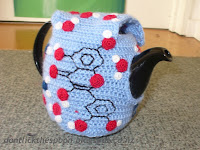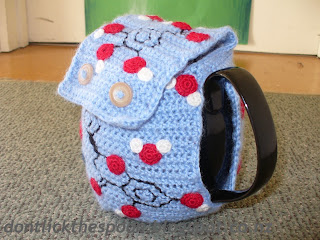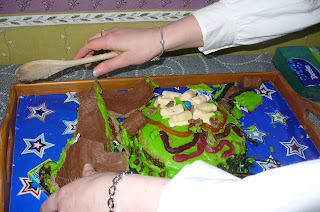I bought the pattern for this hat a while ago, but found that it's sized for midgets (seriously, who has a 45 cm (18 in) head?). However, the cabling pattern is super awesome, so I adapted it to make a pair of gloves. I made them out of a super soft alpaca yarn, so unfortunately it's hard to see the cables in the photos (plus my camera has a scratch on the lens).
4 ply yarn
4.5 mm hook
Gauge is 8 post dc and 8 rows in 5 cm (4 in) (make sure you work a couple of rows before measuring - the foundation row is very loose)
Made to fit my hand which are 19.5 cm (8.5 in) around just above the thumb. There is some stretch, so will fit other sizes close this, but different sizes can be made with different sized hooks.
Stitches
- All of the hdc stitches are worked in the back loops for even rows and front loops for odd rows. This give the fabric more elasticity.
- cable over - Worked over 4 fpdc/fptr from the previous row. Sk first two fpdc, fptr around next two fpdc, fptr around first two fpdc. When working the next row, make sure that you work the st in the order that you made them (actually the opposite order, as there is a turn at the beginning of each row).
- cable under - Worked over 4 fpdc/fptr from the previous row. Sk first two fpdc, fptr around next two fpdc. Working under the first two fptr, fptr around first two fpdc. This will give a cross in the opposite direction from the cable over. When working the next row, make sure that you work the st in the order that you made them (actually the opposite order, as there is a turn at the beginning of each row).
- hdcdec - Work the first half of a hdc on each of the next 2 st (still in the back/front loops as appropriate), then yo and draw through all 3 loops on hook (yo, insert hook and draw up a loop in next stitch, insert hook and draw up a loop in next st, yo, pull throught all 4 loops).
- fpdcdec - Work the first half of a fpdc on each of the next 2 st, then yo and draw through all 3 loops on hook (yo, insert hook and draw up a loop around the front of the post of the stitch in the row below, yo, pull through 2 loops, yo, insert hook and draw up a loop around the back of the post of the next stitch, yo, pull through 2 loops, yo, pull through all 3 loops.)
- bpdcdec - Work the first half of a bpdc on each of the next 2 st, then yo and draw through all 3 loops on hook (yo, insert hook and draw up a loop around the back of the post of the stitch in the row below, yo, pull through 2 loops, yo, insert hook and draw up a loop around the back of the post of the next stitch, yo, pull through 2 loops, yo, pull through all 3 loops.
- foundation dc - ch3, yo, insert hook through the 2 loops of the top of the first chain, pull up a loop, yo, draw through first loop on hook (#). yo, draw through 2 loops, yo, draw through 2 loops. *Yo, insert hook through stitch made here (#), pull up a loop, yo, draw through first loop on hook (#). yo, draw through 2 loops, yo, draw through 2 loops*. Between * * is one foundation dc.
Pattern
r1: foundation dc 35, (this includes the initial ch3 as the first stitch). Yo, insert hook through bottom of last stitch (indicated by (#) in instructions) and the very first ch stitch of the row. Join with a sl st, yo, draw through 2 loops, yo, draw through 2 loops. Note: This is essentially the same as the previous stitches, except that the first part is worked so that it joins up with the start of the row. Join with a sl st in the top of the first foundation dc (not the starting chain). (36 foundation dc)
r2: ch 2 (counts as fpdc), turn. *2bpdc, 2fpdc, 2bpdc, 2fpdc, 2bpdc, 2fpdc, 2bpdc, fpdc, 2bpdc,* fpdc, repeat between * *. Join with a sl st in first bpdc. (20bpdc, 16fpdc. 36 st total)
r3: ch 2 (counts as bpdc), turn. *2fpdc, bpdc, 2fpdc, 2bpdc, 2fpdc, 2bpdc, 2fpdc, 2bpdc, 2fpdc,* bpdc, repeat between * *. Join with a sl st in first fpbc. (20fpdc, 16bpdc. 36 st total)
r4: repeat r2.
r5: repeat r3.
r6: ch 2 (counts as hdc), turn. *2bpdc, 2hdc* 4 times, 2hdc. *2bpdc, 2hdc* 4 times, hdc. Join with a sl st in first bpbc. (16bpdc, 20hdc. 36 st total)
r7: ch 2 (counts as hdc), turn. hdc, *2hdc, 2fpdc* 4 times. 2hdc, *2hdc, 2fpdc* 4 times. Join with a sl st in first hdc. (16fpdc, 20hdc. 36 st total)
r8: ch 2 (counts as hdc), turn. *2bpdc, 2hdc, hdc in next fpdc, bpdc around same st, bpdc, sk next 2 hdc, bpdc, bpdc, hdc in same st, 2hdc, 2bpdc*. 4hdc, repeat between * *, 3hdc. Join with a sl st in first bpbc. (16bpdc, 20hdc. 36 st total)
r9: ch 2 (counts as hdc), turn. 3hdc, *hdc in next bpdc, fpdc around same st, fpdc, hdcdec, hdc, cable over, hdc, hdcdec, fpdc, fpdc, hdc in same st*. 4hdc, repeat between * *. Join with a sl st in first hdc. (8fpdc, 8fptr, 20hdc. 36 st total)
r10: ch 2 (counts as hdc), turn. hdc, *hdc in next fpdc, bpdc around same st, fpdc, sk next 2 hdc, bpdc, bpdc, hdc in same st, hdc in next fpdc, bpdc around same st, bpdc, sk next 2 hdc, bpdc, bpdc, hdc in same st*. 6hdc, repeat between * *, 4hdc. Join with a sl st in first hdc. (16bpdc, 20hdc. 36 st total)
r11: ch 2 (counts as hdc), turn. 5hdc, *cable under, 2hdc, cable under*. 8hdc, repeat between * *, 2hdc. Join with a sl st in first hdc. (16fptr, 20hdc. 36 st total)
r12: ch 2 (counts as hdc), turn. hdcdec *bpdc, bpdc, hdc in same st, hdc in next bpdc, bpdc around same st, bpdc*, sk next 2 hdc, repeat between * *, hdcdec, 4hdc, hdcdec, repeat between * *, sk next 2 hdc, repeat between * *, hdcdec, 3hdc. Join with a sl st in first hdc. (16bpdc, 20hdc. 36 st total)
r13: ch 2 (counts as hdc), turn. hdc, *hdcdec in next 3 st (draw up 3 loops instead of two), fptr, fptr, hdc in same 2 st, 2hdc, cable over, 2 hdc, hdc in next 2 bpdc, fptr around same 2 st*. hdcdec in next 3 st (draw up 3 loops instead of two), repeat between * *, sk last hdc. Join with a sl st in first hdc. (16fptr, 20hdc. 36 st total)
r14: ch1, turn, sl st into last fptr from previous round, ch 2 (doesn't add to st count), turn. bpdc around second-to-last fptr from previous round, hdc in same st, *2hdcdec, 2bptr, hdc in same 2 st, hdc in next 2 fptr, bptr around same 2 st, 2hdcdec, hdc in next fptr, bpdc around same st, bpdc, sk next 2 hdc*. bpdc, bpdc, hdc in same st, repeat between * *, bpdc around first bptr from previous round. Join with a sl st in first bpdc. (8bpdc, 8bptr, 20hdc. 36 st total)
r15: ch 2 (doesn't add to st count), turn. cable over across first bpdc and last 3 bpdc from previous row. *3hdc, 2fpdc, 4hdc, 2fpdc, 3hdc*. cable over, repeat between * *. Join with a sl st in first fptr. (8fpdc, 8fptr, 20hdc. 36 st total)
r16: ch 2 (doesn't add to st count), turn. *hdcdec, hdc, hdc in next 2 fptr, 2bptr around same 2 st, sk 4 hdc, 2bptr, hdc in same 2 st, hdc, hdcdec, bpdc, bpdc, hdc in same st, hdc, bpdc around same st, bpdc,* repeat between * *. Join with a sl st in first hdc. (8bpdc, 8bptr, 20hdc. 36 st total)
r17: ch 1, turn, sl st in last bpdc, ch 2 (counts as hdc), hdc, *2hdc, hdc in next 2 bpdc, fptr around same 2 st, 2hdcdec, cable over, 2hdcdec,* 2fptr, 2 hdc in same 2 st, repeat between * *, 2fptr. Join with a sl st in first hdc. (8fpdc, 8fptr, 20hdc. 36 st total)
r18: ch 2 (counts as hdc), turn. *hdc in next fptr, bpdc around same st, bpdc, sk next 2 st, bpdc, bpdc, hdc in same st, hdc in next fptr, bpdc around same st, bpdc, sk next 2 st, bpdc, bpdc, hdc in same st*. 6hdc, repeat between * *, 5hdc. Join with a sl st in first hdc. (16bpdc, 20hdc. 36 st total)
r19: ch 2 (counts as hdc), turn. *6hdc, cable under, 2hdc, cable under*. 2hdc, repeat between * *, hdc. Join with a sl st in first hdc. (16fptr, 20hdc. 36 st total)
r20: ch 2 (counts as hdc), turn. sk last hdc from previous round, *bpdc, bpdc, hdc in same st, hdc in next fptr, bpdc around same st, bpdc, sk next 2 st, bpdc, bpdc, hdc in same st, hdc in next fptr, bpdc around same st, bpdc, hdcdec, 4hdc*. hdcdec, repeat between * *. Join with a sl st in first bpdc. (16bpdc, 20hdc. 36 st total)
r21: ch 2 (counts as hdc), turn. hdcdec, *hdc, hdcdec, fpdc, fpdc, hdc in same st, 2hdc, cable over, 2hdc, hdc in next bpdc, fpdc around same st, fpdc*. hdcdec, hdc, repeat between * *. Join with a sl st in first hdc. (8fpdc, 8fptr, 20hdc. 36 st total)
r22: ch 2 (counts as hdc), turn. *2bpdc, hdc, hdcdec, bpdc, bpdc, hdc in same st, hdc in next fptr, bpdc around same st, bpdc, hdcdec, hdc, 2bpdc*. 4hdc, repeat between * *, 3hdc. Join with a sl st in first bpdc. (8bpdc, 8bptr, 20hdc. 36 st total)
r23: Repeat row 7.
r24 - r29: Repeat rows 6 - 11.
r30: ch 1, sl st in 2nd hdc from previous round (to the middle of the hdc section), ch2 (counts as dc), turn. hdc, hdcdec, *bpdc, bpdc, hdc in same st, hdc in next fpdc, bpdc around same st, bpdc*, sk next 2 hdc, repeat between * *, hdcdec, 4hdc, hdcdec, repeat between * *, sk next 2 hdc, repeat between * *, hdcdec, hdc, dc. Don't join. (16bpdc, 18hdc, 2dc. 36 st total)
r31: ch 2 (counts as dc), turn. hdcdec, *fptr, fptr, hdc in same 2 st, 2hdc, cable over, 2 hdc, hdc in next 2 bpdc, fptr around same 2 st*. hdcdec in next 3 st (draw up 3 loops instead of two), hdcdec in next 3 st (draw up 3 loops instead of two), repeat between * *, hdcdec, dc. (16fpdc, 18hdc, 2dc. 36 st total)
r32: ch 2 (counts as dc), turn. *bpdc, bpdc, hdc in same st, 2hdcdec, 2bptr, hdc in same 2 st, hdc in next 2 fptr, bptr around same 2 st, 2hdcdec, hdc in next bptr, bpdc around same st, bpdc*. sk next 2 hdc, repeat between * *, sk last hdcdec, dc. (8bpdc, 8bptr, 20hdc, 2dc. 36 st total)
r33: ch 2 (counts as dc), turn. 2fpdc, *3hdc, 2fpdc, 4hdc, 2fpdc, 3hdc*. cable over, repeat between * *, 2fpdc, dc. (8fpdc, 8fptr, 20hdc, 2dc. 36 st total)
r34: ch 2 (counts as dc), turn. hdc, bpdc around same st, bpdc, *hdcdec, hdc, hdc in next 2 fptr, 2bptr around same 2 st, sk 4 hdc, 2bptr, hdc in same 2 st, hdc, hdcdec, bpdc, bpdc, hdc in same st*. hdc, bpdc around same st, bpdc, repeat between * *, dc. (8bpdc, 8bptr, 20hdc, 2dc. 36 st total)
r35: ch 2 (counts as dc), turn. *hdc, hdc in next 2 bpdc, fptr around same 2 st, 2hdcdec, cable over, 2hdcdec,* 2fptr, 2 hdc in same 2 st, hdc, repeat between * *, 2fptr, 2 hdc in same 2 st, hdc, dc. (8fpdc, 8fptr, 20hdc, 2dc. 36 st total)
r36: ch 2 (counts as hdc), turn. 3hdc, *hdc in next fptr, bpdc around same st, bpdc, sk next 2 st, bpdc, bpdc, hdc in same st, hdc in next fptr, bpdc around same st, bpdc, sk next 2 st, bpdc, bpdc, hdc in same st*. 6hdc, repeat between * *, 3hdc, dc. (16bpdc, 20hdc, 2dc. 36 st total)
r37: ch 2 (counts as hdc), turn. *4hdc, cable under, 2hdc, cable under, 4hdc*. Repeat between * *, dc. Join with a sl st in first hdc. (16fptr, 20hdc, 2dc. 36 st total)
r38: ch 2 (counts as hdc), turn. 2hdcdec. hdc, *bpdc, bpdc, hdc in same st, hdc in next fptr, bpdc around same st, bpdc, sk next 2 st, bpdc, bpdc, hdc in same st, hdc in next fptr, bpdc around same st, bpdc*. hdcdec, 4hdc, hdcdec, repeat between * *, 2hdcdec. Join with a sl st in first hdcdec. (16bpdc, 20hdc. 36 st total)
r39: ch 2 (counts as hdc), turn. *hdcdec, fpdc, fpdc, hdc in same st, 2hdc, cable over, 2hdc, hdc in next bpdc, fpdc around same st, fpdc*. hdcdec, 2hdc, repeat between * *, hdcdec, hdc. Join with a sl st in first hdcdec. (8fpdc, 8fptr, 20hdc. 36 st total)
r40: ch 2 (counts as hdc), turn. 2hdc, *2bpdc, hdc, hdcdec, bpdc, fpdc, hdc in same st, hdc in next fptr, bpdc around same st, bpdc, hdcdec, hdc, 2bpdc*. 4hdc, repeat between * *, hdc. Join with a sl st in first bpdc. (8bpdc, 8bptr, 20hdc. 36 st total)
r41: ch 2 (counts as hdc), turn. hdc, *2fpdc, 2hdc* 4 times. 2hdc, *2fpdc, 2hdc* 4 times. Join with a sl st in first hdc. (16fpdc, 20hdc. 36 st total)
r42: ch 2 (counts as hdc), turn. *2hdc, 2bpdc* 4 times. 2hdc, *2hdc, 2bpdc* 4 times, hdc. Join with a sl st in first hdc. (16bpdc, 20hdc. 36 st total)
r43: ch1, turn, ch 2 (counts as bpdc). *2fpdc, 2bpdc, 2fpdc, 2bpdc, 2fpdc, 2bpdc, 2fpdc, bpdc, 2fpdc,* bpdc, repeat between * *. Join with a sl st in first fpdc. (20fpdc, 16bpdc. 36 st total)
r44: ch 2 (counts as bpdc), turn. *2bpdc, fpdc, 2bpdc, 2fpdc, 2bpdc, 2fpdc, 2bpdc, 2fpdc, 2bpdc,* fpdc, repeat between * *. Join with a sl st in first bpbc. (20bpdc, 16fpdc. 36 st total)
r45: Repeat row 43.
r46: Repeat row 44.
r47: Repeat row 43. Fasten off, tuck in ends.
Thumb
rA: Attach yarn to the top of the dc at the end of row 30 (left hand side) and pull up a loop. hdc around the same dc (working towards the start of row 30), 2hdc in stitches from row 29, hdc around ch2 from start of row 30, sl st into top of ch2. (4hdc)
rB: sl st into top of dc from end of row 31, turn. hdc around same st, hc in top of 4hdc from row A, hdc around ch2 from beginning of row 31, sl st into top of ch2. (6hdc)
rC: sl st into top of dc from end of row 32, turn. hdc around same st, hc in top of 6hdc from row B, hdc around ch2 from beginning of row 32, sl st into top of ch2. (8hdc)
rD: sl st into top of dc from end of row 33, turn. hdc around same st, hc in top of 8hdc from row C, hdc around ch2 from beginning of row 33, sl st into top of ch2. (10hdc)
rE: ch2 (counts as hdc), turn. hdc in top of 10hdc from row D, hdc in same st as sl st from row D, 9 hdc around ch2/dc around the edge of thumb hole. Join with a sl st in first hdc. (21hdc)
rF: ch2 (counts as hdc), turn. 4hdc, hdcdec, 3hdc, hdcdec, 7hdc, hdcdec. Join with a sl st in first hdc. (18hdc)
rG: ch2 (counts as bpdc), turn. fpdcdec, fpdc, 2bpdc, 2fpdc, bpdcdec, bpdc, 2fpdc, 2bpdc, 2fpdc, bpdc. Join with a sl st in first fpdc. (8fpdc, 8bpdc. 16 st total)
rH: ch2 (counts as bpdc), turn. bpdc, *2fpdc, 2bpdc*, repeat between * * twice, 2fpdc. Join with a sl st in first bpdc. (8fpdc, 8bpdc. 16 st total)
rI: ch2 (counts as fpdc), turn. *2fpdc, 2bpdc*, repeat between * * twice, 2fpdc, bpdc. Join with a sl st in first fpdc. (8fpdc, 8bpdc. 16 st total)
rJ: Repeat row H. Fasten off, tuck in ends.








































